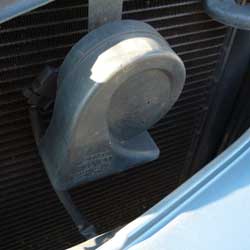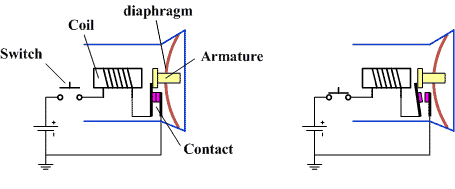 Car horns are simple electromagnetic devices that produce loud, audible sounds to get the attention of nearby vehicle occupants or pedestrians. A typical horn is composed of a magnetic coil, an armature with a metal diaphragm, a pair of electrical contacts, and a switch. When the driver activates the switch, the closed electric contact allows a current to flow through the coil generating a magnetic force that attracts the armature, as well as the metal diaphragm. This action breaks the electric contact, cutting off the current and releasing the armature and diaphragm. When they move back to their initial positions, the electrical contact is re-made and the cycle repeats. The rapid repetition of this process generates an oscillation of the diaphragm and creates the horn’s sound.
Car horns are simple electromagnetic devices that produce loud, audible sounds to get the attention of nearby vehicle occupants or pedestrians. A typical horn is composed of a magnetic coil, an armature with a metal diaphragm, a pair of electrical contacts, and a switch. When the driver activates the switch, the closed electric contact allows a current to flow through the coil generating a magnetic force that attracts the armature, as well as the metal diaphragm. This action breaks the electric contact, cutting off the current and releasing the armature and diaphragm. When they move back to their initial positions, the electrical contact is re-made and the cycle repeats. The rapid repetition of this process generates an oscillation of the diaphragm and creates the horn’s sound.
In general, there are two types of horn shapes: plate and spiral. The plate type is smaller and lighter. It is also more easily installed on a car. The spiral type employs a spiral duct to obtain a richer sound. Most horns assemblies have two horns (low and high notes) and achieve sound levels of approximately 107-109 decibels.
The frequency of the horn is usually related to the size of the vehicle. Bigger vehicles generally have lower frequency horns, while smaller vehicles have higher frequency horns. The sound for luxury cars is often "smooth" compared to economy cars with less refined tones. Many countries mandate a car's specific horn frequency.

Horns installed on trucks are usually driven by compressed air instead of current. Air horns can generate very loud sounds, typically at levels of 117-118 decibels.

